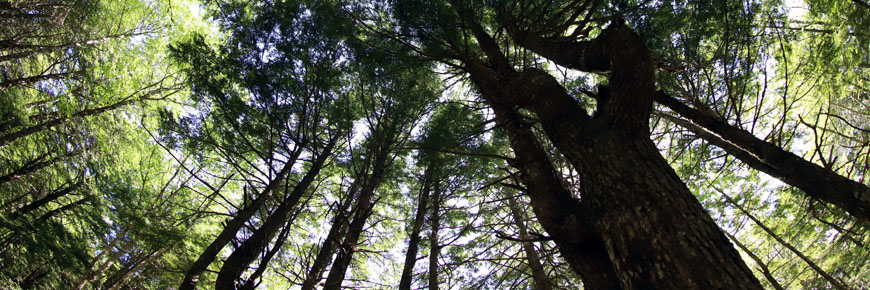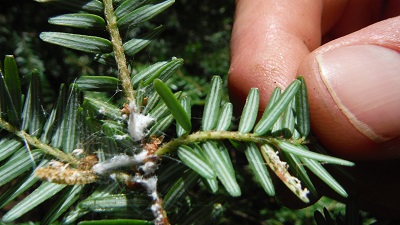
Forest ecosystem conservation
Kejimkujik National Park and National Historic Site
Protecting Kejimkujik's hemlock legacy, Kejimkujik National Park and National Historic Site
The Acadian forest
Kejimkujik lies within the Acadian Forest region, a unique and complex forest that features a mix of temperate tree species with ranges that extend south into Ontario and the United States, and more northern boreal trees.
Human activity has changed these forests dramatically over the last two hundred years. Farmers cleared hardwoods from hills and loggers cut giant White pine and Red spruce, and later harvested wood for pulp.
Current threats to the Acadian forest in Kejimkujik include climate change and invasive species.
Eastern hemlock, the defining tree of Kejimkujik
As one of the longest-lived trees in eastern North America, Eastern hemlock forms stands that represent among the last old-growth forests in Nova Scotia. Hemlock is a foundational species of the Acadian forest: it performs unique ecological functions and creates its own environmental conditions. Hemlocks support breeding birds, provide winter thermal cover for wildlife, and protect aquatic ecosystems by regulating waterflow, preventing erosion and shading streams.
Hemlock trees and the cool and shaded forests they create are an essential part of the Kejimkujik experience; many of our visitor facilities are located in hemlock stands.
The threat: Hemlock woolly adelgid

Hemlock woolly adelgid, or HWA, is an invasive alien (or non native) insect that is damaging and killing Eastern hemlock. Southwest Nova Scotia is the first location in Canada to have an established population of HWA, and since that detection in 2017, Parks Canada and partners have formed a multi-stakeholder working group to share information and respond to this new threat with a regional lens.
HWA was detected in Kejimkujik in 2018, and park forests are changing rapidly and showing signs of decline. There are no known natural predators of HWA in Nova Scotia, and introduced biocontrol agents are still in the experimental stage, at least a decade away from being an option. Scientists predict up to 80% of all hemlock trees in southwestern Nova Scotia will die by 2030 as a result of HWA.
Adaptive management is required to slow the spread of HWA and increase hemlock resiliency.
What is Parks Canada doing about it?
The control of firewood importation is an important measure in protecting the forest, reducing further spread and infestation of HWA and limiting the introduction of other invasive insects. Parks Canada introduced a firewood importation ban in 2018; only firewood purchased in the park is permitted.
Parks Canada has developed a five-year project that will increase Parks Canada’s understanding of HWA, enhance the resiliency of hemlock forests infested with HWA, slow the spread of HWA within and beyond Kejimkujik, and limit the impact of HWA on Kejimkujik’s old-growth forests. This project will also help protect Kejimkujik visitor experiences and facilities in Jeremy’s Bay Campground, Mill Falls day-use area, and Hemlock and Hardwoods trail. Parks Canada has initiated consultation with the Mi’kmaq of Nova Scotia to learn how Indigenous world views and traditional ways of knowing the land can improve management actions.
Research
Since 2018, staff have been surveying priority hemlock stands throughout the park to determine the extent and severity of HWA infestations. In 2020, staff began recording baseline hemlock canopy health conditions to determine the current impacts of HWA infestations and rates of decline in Kejimkujik. These surveys have revealed trees throughout the park that are changing rapidly and showing signs of decline, including in Jeremy's Bay Campground.
What’s Next?
Addressing the impact of HWA on hemlock within Jeremy’s Bay Campground is of critical concern to Parks Canada. The forest canopy in the campground is dominated by Eastern hemlock and the level of HWA infestation is moderate to high throughout. Parks Canada has adopted an active management approach in Jeremy’s Bay Campground using restorative silviculture to help the hemlock-dominant forest transition toward a more resilient hardwood forest. This includes cutting hemlock trees and planting saplings of other species, including Red oak, Yellow birch, Sugar maple, and White pine.
Parks Canada’s five-year project plan to manage priority Eastern hemlock forests at Kejimkujik includes:
- removing 30% of hemlock trees in Jeremy's Bay Campground (3,500) to increase light availability to the forest floor and promote the establishment of other, more resilient species. Increased light levels may also slow the spread and reduce the overall population of HWA, and further enhance the health of remaining hemlock trees.
o In 2021 we removed approximately 1,000 hemlock from the campground and identified areas for tree planting and restoration work
- planting or transplanting 2,000 new trees in Jeremy's Bay Campground, of other species such as hardwood species like red oak, yellow birch, or sugar maple, and softwood species like red spruce and white pine.
o In 2021 we planted approximately 1,500 red oak and red maple saplings in the campground, with the help of staff and over 200 volunteers
- piloting the use of a chemical insecticide in prioritized and carefully selected hemlock stands in Kejimkujik. Individual trees are treated via stem injection.
o In Fall 2021, we treated 500 trees near Hemlocks and Hardwoods trail
o In Spring 2022, we treated 350 trees in Jeremy’s Bay Campground
o In Fall 2022, we treated 1,200 trees at remote Dennis Boot Lake
Because of the complexity of the proposed management actions, Parks Canada, under the Impact Assessment Act, conducted a Detailed Impact Assessment (DIA) to evaluate the potential adverse impacts of the project plan. The project is not likely to cause significant adverse environmental effects and now incorporates additional mitigation measures based on feedback during the consultation process.
Resources
- Date modified :